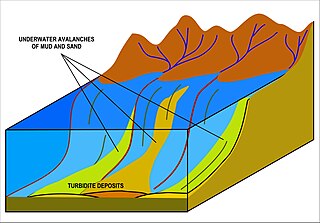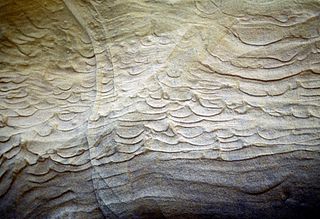
Sedimentary rocks are types of rock that are formed by the accumulation or deposition of mineral or organic particles at Earth's surface, followed by cementation. Sedimentation is the collective name for processes that cause these particles to settle in place. The particles that form a sedimentary rock are called sediment, and may be composed of geological detritus (minerals) or biological detritus. The geological detritus originated from weathering and erosion of existing rocks, or from the solidification of molten lava blobs erupted by volcanoes. The geological detritus is transported to the place of deposition by water, wind, ice or mass movement, which are called agents of denudation. Biological detritus was formed by bodies and parts of dead aquatic organisms, as well as their fecal mass, suspended in water and slowly piling up on the floor of water bodies. Sedimentation may also occur as dissolved minerals precipitate from water solution.

Sediment is a naturally occurring material that is broken down by processes of weathering and erosion, and is subsequently transported by the action of wind, water, or ice or by the force of gravity acting on the particles. For example, sand and silt can be carried in suspension in river water and on reaching the sea bed deposited by sedimentation; if buried, they may eventually become sandstone and siltstone through lithification.

Conglomerate is a clastic sedimentary rock that is composed of a substantial fraction of rounded to subangular gravel-size clasts. A conglomerate typically contain a matrix of finer-grained sediments, such as sand, silt, or clay, which fills the interstices between the clasts. The clasts and matrix are typically cemented by calcium carbonate, iron oxide, silica, or hardened clay.

A turbidite is the geologic deposit of a turbidity current, which is a type of amalgamation of fluidal and sediment gravity flow responsible for distributing vast amounts of clastic sediment into the deep ocean.

A turbidity current is most typically an underwater current of usually rapidly moving, sediment-laden water moving down a slope; although current research (2018) indicates that water-saturated sediment may be the primary actor in the process. Turbidity currents can also occur in other fluids besides water.
A way up structure, way up criterion, or geopetal indicator is a characteristic relationship observed in a sedimentary or volcanic rock, or sequence of rocks, that makes it possible to determine whether they are the right way up or have been overturned by subsequent deformation. This technique is particularly important in areas affected by thrusting and where there is a lack of other indications of the relative ages of beds within the sequence, such as in the Precambrian where fossils are rare.

The Bouma Sequence describes a classic set of sedimentary structures in turbidite beds deposited by turbidity currents at the bottoms of lakes, oceans and rivers.

Clastic rocks are composed of fragments, or clasts, of pre-existing minerals and rock. A clast is a fragment of geological detritus, chunks and smaller grains of rock broken off other rocks by physical weathering. Geologists use the term clastic with reference to sedimentary rocks as well as to particles in sediment transport whether in suspension or as bed load, and in sediment deposits.

In geology, cross-bedding, also known as cross-stratification, is layering within a stratum and at an angle to the main bedding plane. The sedimentary structures which result are roughly horizontal units composed of inclined layers. The original depositional layering is tilted, such tilting not being the result of post-depositional deformation. Cross-beds or "sets" are the groups of inclined layers, which are known as cross-strata.

In geology, ripple marks are sedimentary structures and indicate agitation by water or wind.

In geology, a graded bed is one characterized by a systematic change in grain or clast size from one side of the bed to the other. Most commonly this takes the form of normal grading, with coarser sediments at the base, which grade upward into progressively finer ones. Such a bed is also described as fining upward. Normally graded beds generally represent depositional environments which decrease in transport energy as time passes, but these beds can also form during rapid depositional events. They are perhaps best represented in turbidite strata, where they indicate a sudden strong current that deposits heavy, coarse sediments first, with finer ones following as the current weakens. They can also form in terrestrial stream deposits.

In geology, a bed is a layer of sediment, sedimentary rock, or pyroclastic material "bounded above and below by more or less well-defined bedding surfaces". Specifically in sedimentology, a bed can be defined in one of two major ways. First, Campbell and Reineck and Singh use the term bed to refer to a thickness-independent layer comprising a coherent layer of sedimentary rock, sediment, or pyroclastic material bounded above and below by surfaces known as bedding planes. By this definition of bed, laminae are small beds that constitute the smallest (visible) layers of a hierarchical succession and often, but not always, internally comprise a bed.

Sedimentary structures include all kinds of features in sediments and sedimentary rocks, formed at the time of deposition.

In geology, lamination is a small-scale sequence of fine layers that occurs in sedimentary rocks. Laminae are normally smaller and less pronounced than bedding. Lamination is often regarded as planar structures one centimetre or less in thickness, whereas bedding layers are greater than one centimetre. However, structures from several millimetres to many centimetres have been described as laminae. A single sedimentary rock can have both laminae and beds.

A contourite is a sedimentary deposit commonly formed on continental rise to lower slope settings, although they may occur anywhere that is below storm wave base. Countourites are produced by thermohaline-induced deepwater bottom currents and may be influenced by wind or tidal forces. The geomorphology of contourite deposits is mainly influenced by the deepwater bottom-current velocity, sediment supply, and seafloor topography.

Parting lineation is a subtle sedimentary structure in which sand grains are aligned in parallel lines or grooves on the surface of a body of sand. The orientation of the lineation is used as a paleocurrent indicator, although the precise flow direction is often indeterminable. They are also the primary indicator of the lower part of the upper flow regime bedform.

Soft-sediment deformation structures develop at deposition or shortly after, during the first stages of the sediment's consolidation. This is because the sediments need to be "liquid-like" or unsolidified for the deformation to occur. These formations have also been put into a category called water-escape structures by Lowe (1975). The most common places for soft-sediment deformations to materialize are in deep water basins with turbidity currents, rivers, deltas, and shallow-marine areas with storm impacted conditions. This is because these environments have high deposition rates, which allows the sediments to pack loosely.

A sediment gravity flow is one of several types of sediment transport mechanisms, of which most geologists recognize four principal processes. These flows are differentiated by their dominant sediment support mechanisms, which can be difficult to distinguish as flows can be in transition from one type to the next as they evolve downslope.

The Lowe sequence describes a set of sedimentary structures in turbidite sandstone beds that are deposited by high-density turbidity currents. It is intended to complement, not replace, the better known Bouma sequence, which applies primarily to turbidites deposited by low-density turbidity currents.

Liquefied flows are types of sediment-gravity flows in which grains within the flow are kept in suspension by the upward movement of fluid. They form in granular substances where the concentration of suspended mud is too low to develop cohesive forces within the flow. As grains at the base of the suspension settle out, fluid that is displaced upward by the settling generates pore fluid pressures that can help suspend grains in the upper part of the flow. Application of an external pressure to the suspension will initiate flow. This external pressure can be applied by a seismic shock, which may turn transform loose sand into a highly viscous suspension as in quicksand. Generally as soon as the flow begins to move, fluid turbulence results and the flow rapidly evolves into a turbidity current. Flows and suspensions are said to be liquefied when the grains settle downward through the fluid and displace the fluid upwards. By contrast, flows and suspensions are said to fluidized when the fluid moves upward through the grains, thereby temporarily suspending them. Most flows are liquefied, and many references to fluidized sediment gravity flows are in fact incorrect and actually refer to liquified flows. Because fluid is displaced upward in these types of flows, dewatering features such as dish structures, pillars, pipes and dikes are common.

















